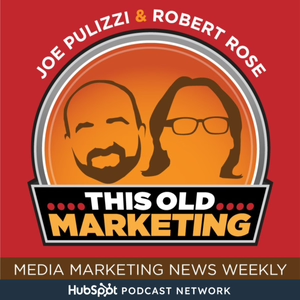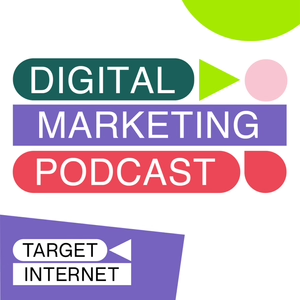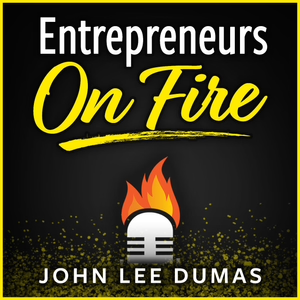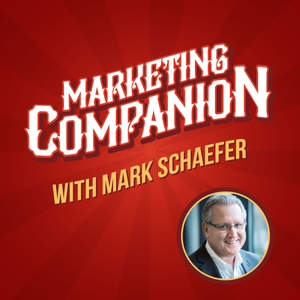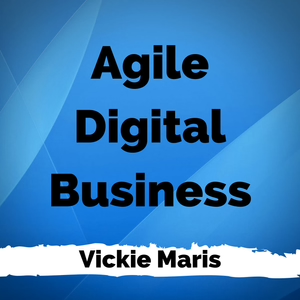
Leader Effectiveness | Pete DeLisle Interview Part 2
10/22/20 • 40 min
Pete DeLisle, PhD, uses memorable case studies and stories to reflect on leader effectiveness that you can incorporate into your own style of leadership. He is my guest in Episode 35 of Agile Digital Business.
Show notes, time codes and key take-aways:
0:00 A snippet of Pete teaching about the reciprocity behaviors of the Apollo 13 (you can watch the movie as homework!)
:35 Intro of Episode 35 of Agile Digital Business
:55 Request that you grab a screenshot of the show and share it on your favorite social media channel
1:16 Reminder that you can find key takeaways from this episode and others when you search on: #teachinspireconnect #agiledigitalbiz
3:04 Pete was a guest in Episode 32 of the show for the Part 1 interview
3:30 Welcoming Dr. Pete DeLisle back to the mic!
4:15 Pete teaches in the executive education. You can hear more of Pete's bio back in Episode 32.
... Framing the leader effectiveness theory ...
4:38 Introducing elements of leader effectiveness: awareness of self; awareness of other people (what's going on with them); situational awareness (what's going on around you). Leadership is the ability to influence people with or without authority.
6:42 "Leading without authority, to me, is a much higher form of leadership." - Pete DeLisle, PhD
6:58 The ability to make hard decisions.
7:30 The next element of the ability to lead is foresight.
7:46 Working through the what-might-happen-if scenarios.
8:06 Foresight causes a leader to develop a sense of preparedness.
8:32 Pete talks about the ethos of the US Coast Guard. Their motto is semper paratus. Their underlying ethos is: "We have to go out. We don't necessarily have to come back."
8:50 The last element of effective leadership is commitment. The three levels of engagement include volunteer, duty and reciprocity.
10:30 A question about the stage of a career at which a person thinks about the elements of an effective leader.
11:53 Ensuring that you're taking care of the folks you're working with. "If you don't have folks to do the job, frankly, the job doesn't get done." - Pete DeLisle, PhD
12:37 "We see many organizations that just drive people into the ground. They treat people as if they're expendable. They may be successful for a short period of time, but they don't last long.
Sometimes we see organizations that are much more concerned about the welfare of folks, and they forget how to do business." - Pete DeLisle, PhD
13:20 "If I owned this business, how would I be handling this situation?" - a lens to use when viewing the actions of a leader. - Vickie Maris
15:45 References to the movie, and the real-live event of Apollo 13 ("One of the best movies on leadership and problem solving that you'll ever see." - Pete DeLisle, PhD)
17:30 Astronaut Capt. Jim Lovell's act of courage was to say out loud, over the air, in front of everybody, "Houston, we've got a problem."
18:15 The team on the ground had an absolute commitment to help them be safe and to get them home.
20:00 This episode is sponsored by the group coaching and courses offered through Mastermind.com by Vickie Maris.
Coaching Group: Introduction to Live-streaming and Engaging in Social Media
Coaching Group: DIY Course Creation and Recording of Direct-to-Camera Videos
Self-Study: DIY Course Creation and Recording of Direct-to-Camera Videos
22:45 If you would like to learn more about Pete DeLisle's schedule for teaching in professional development programs, send an email to agiledigitalbusiness @ gmail dot com, and we'll forward your inquiry to Pete. He is teaching in online environments as well as upcoming in-person events.
23:35 Story of Ken Mattingly on the ground in the simulator troubleshooting while his colleagues were in space.
25:11 Story of hearing Jim Lovell and Gene Kranz speak during the Ag Alumni Fish Fry for Purdue University, 2007.
26:10 Relating the story and movie of Apollo 13 to Vickie's dad, Jim Maris, a military pilot and also an educator.
28:16 Discussion about the times when rules need to be broken.
28:37 Brief story about the D-Day experience in a sky full of B-24s with lights out and in radio silence.
30:40 Pete describes an example of when a leader has to consider disobeying an order.
33:04 Pete shares an example of the captain of a US Navy Aircraft carrier making a decision to take the USS Theodore Roosevelt offline.
37:00 Homework ass...
Pete DeLisle, PhD, uses memorable case studies and stories to reflect on leader effectiveness that you can incorporate into your own style of leadership. He is my guest in Episode 35 of Agile Digital Business.
Show notes, time codes and key take-aways:
0:00 A snippet of Pete teaching about the reciprocity behaviors of the Apollo 13 (you can watch the movie as homework!)
:35 Intro of Episode 35 of Agile Digital Business
:55 Request that you grab a screenshot of the show and share it on your favorite social media channel
1:16 Reminder that you can find key takeaways from this episode and others when you search on: #teachinspireconnect #agiledigitalbiz
3:04 Pete was a guest in Episode 32 of the show for the Part 1 interview
3:30 Welcoming Dr. Pete DeLisle back to the mic!
4:15 Pete teaches in the executive education. You can hear more of Pete's bio back in Episode 32.
... Framing the leader effectiveness theory ...
4:38 Introducing elements of leader effectiveness: awareness of self; awareness of other people (what's going on with them); situational awareness (what's going on around you). Leadership is the ability to influence people with or without authority.
6:42 "Leading without authority, to me, is a much higher form of leadership." - Pete DeLisle, PhD
6:58 The ability to make hard decisions.
7:30 The next element of the ability to lead is foresight.
7:46 Working through the what-might-happen-if scenarios.
8:06 Foresight causes a leader to develop a sense of preparedness.
8:32 Pete talks about the ethos of the US Coast Guard. Their motto is semper paratus. Their underlying ethos is: "We have to go out. We don't necessarily have to come back."
8:50 The last element of effective leadership is commitment. The three levels of engagement include volunteer, duty and reciprocity.
10:30 A question about the stage of a career at which a person thinks about the elements of an effective leader.
11:53 Ensuring that you're taking care of the folks you're working with. "If you don't have folks to do the job, frankly, the job doesn't get done." - Pete DeLisle, PhD
12:37 "We see many organizations that just drive people into the ground. They treat people as if they're expendable. They may be successful for a short period of time, but they don't last long.
Sometimes we see organizations that are much more concerned about the welfare of folks, and they forget how to do business." - Pete DeLisle, PhD
13:20 "If I owned this business, how would I be handling this situation?" - a lens to use when viewing the actions of a leader. - Vickie Maris
15:45 References to the movie, and the real-live event of Apollo 13 ("One of the best movies on leadership and problem solving that you'll ever see." - Pete DeLisle, PhD)
17:30 Astronaut Capt. Jim Lovell's act of courage was to say out loud, over the air, in front of everybody, "Houston, we've got a problem."
18:15 The team on the ground had an absolute commitment to help them be safe and to get them home.
20:00 This episode is sponsored by the group coaching and courses offered through Mastermind.com by Vickie Maris.
Coaching Group: Introduction to Live-streaming and Engaging in Social Media
Coaching Group: DIY Course Creation and Recording of Direct-to-Camera Videos
Self-Study: DIY Course Creation and Recording of Direct-to-Camera Videos
22:45 If you would like to learn more about Pete DeLisle's schedule for teaching in professional development programs, send an email to agiledigitalbusiness @ gmail dot com, and we'll forward your inquiry to Pete. He is teaching in online environments as well as upcoming in-person events.
23:35 Story of Ken Mattingly on the ground in the simulator troubleshooting while his colleagues were in space.
25:11 Story of hearing Jim Lovell and Gene Kranz speak during the Ag Alumni Fish Fry for Purdue University, 2007.
26:10 Relating the story and movie of Apollo 13 to Vickie's dad, Jim Maris, a military pilot and also an educator.
28:16 Discussion about the times when rules need to be broken.
28:37 Brief story about the D-Day experience in a sky full of B-24s with lights out and in radio silence.
30:40 Pete describes an example of when a leader has to consider disobeying an order.
33:04 Pete shares an example of the captain of a US Navy Aircraft carrier making a decision to take the USS Theodore Roosevelt offline.
37:00 Homework ass...
Previous Episode

Livestream Basics for Church Pastors | Coaching Call
Listen in on a group coaching call in Episode 34 of Agile Digital Business, in which podcast host, Vickie Maris, was invited to be a guest presenter and coach.
She was speaking with a group of Methodist pastors in Indiana about the basics of livestreaming a church service.
Below are the show notes and time codes for this episode:
0:00 Introduction to Episode 34 of Agile Digital Business: Live Stream Basics for Church Pastors
"Pastors are interested to learn more about how to engage with their participants in an online environment, and how to market the fact that worship services have moved online." - Vickie Maris
1:41 Episode Sponsor - 3-Session Group Coaching: Introduction to Livestreaming and Engaging in Social Media
Sessions are 75 minutes each Jan. 8, 2021; 8 pm Jan. 15, 2021; 8 pm Jan. 22, 2021; 8 pm
https://app.mastermind.com/masterminds/1607
3:00 Start of the coaching group call
4:35 Vickie provides background about the niche where she has been focused in recent years - how to incorporate social media into the overall marketing mix; and how to engage with students, customers and members within social media
5:39 Engaging in social media can be a fantastic evangelistic tool
6:13 Sharing of a quote from a Kyle Cease video on YouTube:
"The reason that you're stressed and scared is because you can tangibly measure what you're going to lose, but it's really hard to see what you're going to gain." - Kyle Cease
"We don't have numbers about the future." - Vickie Maris
7:48 Mention of the Scott Greeson Music page in Facebook
7:59 Mention of the Dawn of Promise Farm business page in Facebook
8:16 Perspective of a musician about the marketing for a church
9:22 Mention of where we're heading with voice technology, smart speakers, Google translating podcasts at the episode level for indexing and other changes
10:00 Discussion about a church's social media presence
10:55 A reminder to update the associated website and to put something on the home page that will alert the web visitor that the information on the website
11:26 Frequency of posting on your church's Facebook page
11:44 Mention of a social media post scheduler, Hootsuite.com. Other services are available - both free and paid.
12:26 Hootsuite has an app which allows you to schedule posts or do live posting from your phone.
12:48 A suggested makeup of social media posts (graphics, quotes, videos, photos, Facebook Lives)
13:02 Don't assume that people will see your post just because you have posted.
14:46 Example provided from the business page in Facebook for Scott Greeson Music. Ask people, within the text of the post, to share the post on their personal profiles.
15:32 Suggestion of texting or calling members of the church (or employees of your business) to join the Facebook Live. Let them know the day and time, and explain how they can help out with liking, sharing, and commenting.
17:20 Use a Facebook Business page for your church rather than your personal profile in Facebook.
17:25 Reference to a post on Vickie's page in Facebook, Teach. Inspire. Connect.
If you share on a phone tree about your online worship service, do that more than once in the week.
Reach out to your email list more than once in the week, and provide instructions in each email about how to access the online worship service.
19:00 Subject headers of emails should be interesting and cause the reader to open the email.
19:36 Sample of an email subject header that would be more likely to grab the reader's attention
20:15 Examples of email sequences from successful entrepreneurs
22:49 Introduction and summary of next section which contains tips for conducting your Facebook Live
25:49 Be sure to look straight into the camera lens as you start your live-stream
26:20 Put your most interesting element upfront in the livestream
27:23 Example of how to invite those in your congregation or audience to help out by joining the broadcast via their phones and share out the broadcast on their profiles
28:03 A thank you to the participants of the call and to John Randall who invited me to teach on the call and provide coaching
28:34 You can let Vickie know about your experiences in applying one of these tools - send an email to her at agiledigitalbusiness @ gmail dot com
28:45 You can learn more about working with Vickie as a coach when you visit her website.
If you'd like to join the next group coaching by Vickie Maris in Mastermind Dot Com, "Introduction to Livestreaming and Social Med...
Next Episode
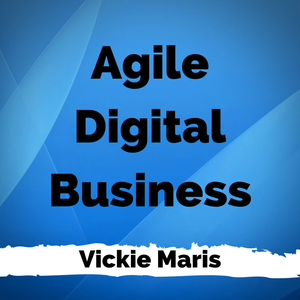
Llamas: A Lesson in Leadership and Team Roles
In Episode 36 of Agile Digital Business, hear insights about leader selection, and about allowing team members to self select into ideal roles.
Vickie Maris, host of the show, teaches in the professional development classroom (and virtual learning spaces) on leadership lessons gleaned from the raising and training of llamas, ponies, and other livestock on her farm.
https://vickiemaris.com/coaching
Show Notes for Episode 36
00:00 Introduction to information about a leader in the USA, NASA astronaut John Glenn - the third person and first American to orbit the Earth. In 1957, he made the first supersonic, transcontinental flight across the United States.
:54 The name of John Glenn is listed in Chapter 2 in the book, Why A Students Work for C Students, by Robert T. Kiyosaki. The list includes 50 people who didn't finish school. There are several presidents, authors, movie directors, playwrites, musicians and business founders and owners on the list.
2:36 Introduction of this episode of Agile Digital Business.
3:13 Leadership development program is referred to: Foundations in Leading Meaningful Change.
3:30 My Zoom call llama, Heartsong, joined me for teaching in a session of a virtual program on Leading Meaningful Change. This lesson was in situational leadership.
For information about booking a llama for your next virtual training or online coffee chat: Book the llamas for an appearance -- heartsongllamasonline.com
4:07 Think about how you select leaders for your organization.
4:33 Consider helping out Wikipedia if you use the web tool as a resource. The fundraising campaign is going now, but they welcome your donation at any point throughout the year. (Click the link to donate.)
5:14 Music plays and then you hear a setup to the instructional content. The audio was captured outdoors, and is a download from a Zoom call.
5:46 You will hear the reactions of people who were enrolled in the Leading Meaningful Change Foundations program.
6:12 The latest book by Beverly Patwell is Leading Meaningful Change: Capturing the Hearts, Minds and Souls of the People You Lead, Work With and Serve.
6:30 Vickie Maris teaches a short example about team roles by discussing a llama pack string hiking out on the trail. It's important to position llamas in the best role for each individual llama as they work on the trail. The ideal role for Heartsong in any scenario, is to serve as the lead llama. She selects this role if she is out grazing with the herd in the pasture or if she is working with a group on the trail.
7:40 Consider allowing your teams to self select into the roles they are best suited for.
8:00 Bev invites people to follow Vickie Maris on LinkedIn where you can hear more insights like the one she shared with her llama Heartsong. https://linkedin.com/in/vickiemaris
8:15 Thank you for listening to Agile Digital Business. An invitation to subscribe to the show is included.
#teachinspireconnect #agiledigitalbiz
If you like this episode you’ll love
Episode Comments
Generate a badge
Get a badge for your website that links back to this episode
<a href="https://goodpods.com/podcasts/agile-digital-business-9282/leader-effectiveness-pete-delisle-interview-part-2-9433886"> <img src="https://storage.googleapis.com/goodpods-images-bucket/badges/generic-badge-1.svg" alt="listen to leader effectiveness | pete delisle interview part 2 on goodpods" style="width: 225px" /> </a>
Copy
